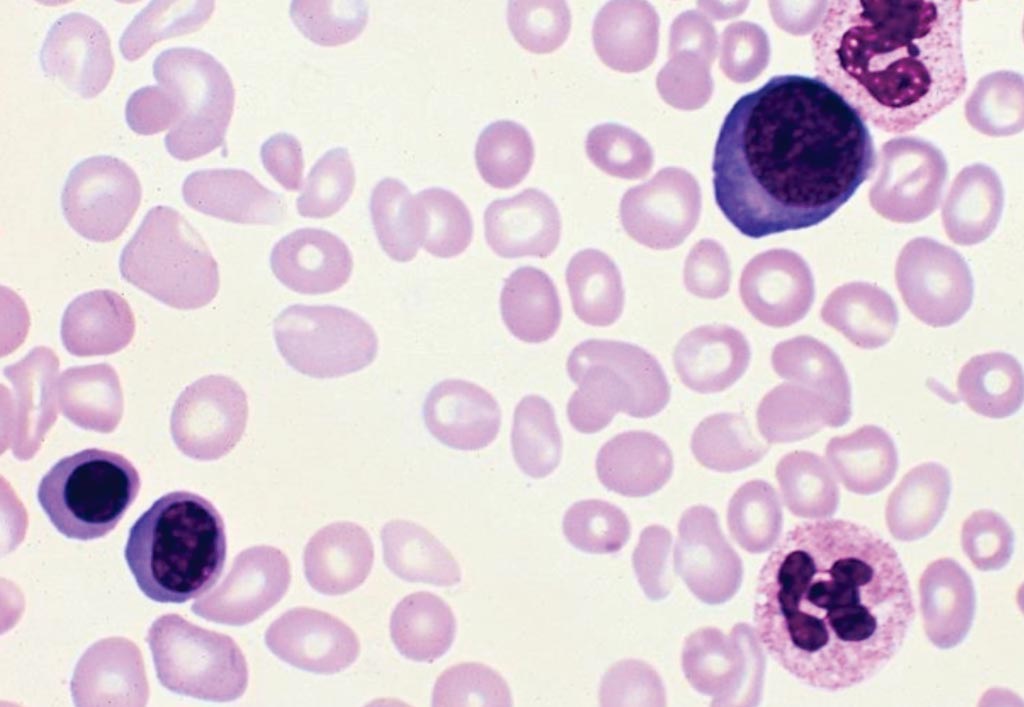Myeloproliferative Neoplasms Fall into Genetic Subgroups
By LabMedica International staff writers
Posted on 31 Oct 2018
Myeloproliferative neoplasms are a group of chronic blood cancers associated with a risk of bleeding and blood clots, but they can also progress to more advanced disease, including leukemia.Posted on 31 Oct 2018
The current classification system divides these blood cancers into groups based on their clinical and laboratory features, but there is some overlap between the categories. The genomic characterization of patients with myeloproliferative neoplasms offers the potential for personalized diagnosis, risk stratification, and treatment.

Image: A blood smear from a 68-year-old woman with a 13-year history of polycythemia vera and there are three red blood cell precursors present and slight to moderate anisopoikilocytosis (Photo courtesy of The Armed Forces Institute of Pathology).
A large team of scientists working with the Wellcome Trust Sanger Institute (Hinxton, UK) sequenced coding exons from 69 myeloid cancer genes in patients with myeloproliferative neoplasms, comprehensively annotating driver mutations and copy-number changes. They developed a genomic classification for myeloproliferative neoplasms and multistage prognostic models for predicting outcomes in individual patients. Classification and prognostic models were validated in an external cohort.
DNA samples underwent library preparation at the Wellcome Trust Sanger Institute, Cambridge, UK. The team used 1,033 granulocyte derived DNA samples that underwent whole genome amplification prior to library preparation. Sequencing libraries were generated in a 96-well format, with each sample carrying a unique DNA barcode. Pools of 16 libraries were made and hybridized to RNA baits. Pools of 96 cases were sequenced on two lanes of a HiSeq 2500 machine using 75bp paired-end sequencing.
The team included a total of 2,035 patients in the analysis. A total of 33 genes had driver mutations in at least five patients, with mutations in JAK2, CALR, or MPL being the sole abnormality in 45% of the patients. The numbers of driver mutations increased with age and advanced disease. Driver mutations, germline polymorphisms, and demographic variables independently predicted whether patients received a diagnosis of essential thrombocythemia as compared with polycythemia vera or a diagnosis of chronic-phase disease as compared with myelofibrosis.
The investigators defined eight genomic subgroups that showed distinct clinical phenotypes, including blood counts, risk of leukemic transformation, and event-free survival. Integrating 63 clinical and genomic variables, they created prognostic models capable of generating personally tailored predictions of clinical outcomes in patients with chronic-phase myeloproliferative neoplasms and myelofibrosis. At the same time, they were able to identify a subgroup that was at low risk of disease progression, which might not benefit from aggressive treatment and instead could be treated more conservatively.
Jyoti Nangalia, PhD, a consultant hematologist and co-author of the study, said, “Our new online calculator takes genetic and clinical information available for a patient and makes a prediction of the future outcome of that particular person's disease. In the future, this could be used to reassure patients who have a good predicted outcome, and identify patients who are at risk of developing severe disease who could benefit from an alternative treatment approach.” The study was published on October 11, 2018, in The New England Journal of Medicine.
Related Links:
Wellcome Trust Sanger Institute













